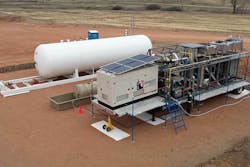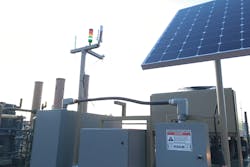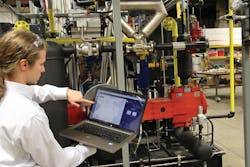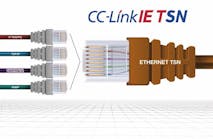Unmanned well sites in remote locations present operational challenges. Data must not only be collected, but it also must be monitored to uncover any discrepancies, and ideally to predict problems before they occur. Advanced analytics software, coupled with a sophisticated data collection system, can address these issues, and also provide additional benefits.
Pioneer Energy in Lakewood, Colorado, is a service provider and original equipment manufacturer solving gas processing challenges in the oil field with a range of standard gas capture and processing units for tank vapors and flare gas.
Pioneer Energy’s VaporCatcher line of units captures hydrocarbon vapors from crude oil tank batteries and extracts natural gas liquids (NGLs) at high yields, instead of sending these commodities to combustion or venting to the atmosphere. This dramatically cuts emissions, meets U.S. Environmental Protection Agency Quad O compliance standards and provides a significant economic return. Its FlareCatcher line of equipment (see Figure 1 above) provides flare gas capture and processing at the well site, producing NGLs and pipeline-quality lean methane, and enabling producers to achieve regulatory compliance.
Oil and gas fields in North Dakota, Montana and Colorado use the vapor and flare gas capture equipment at production well sites to capture methane and natural gas liquid streams. Pioneer Energy operates and monitors these geographically dispersed units from its headquarters in Colorado. Pioneer’s operations and design teams monitor the equipment and analyze the results to deliver continuous improvement.
The flare gas capture and processing equipment is powered with a natural gas generator, which is inside the white enclosure on the front of the trailer as shown in Figure 1. The fuel gas for this generator is provided by any of the refined energy products made by the system, and this usage represents only about 5 percent of the total energy of the gas processed by the equipment.
The system has auxiliary (backup) batteries, which are charged with a conventional battery tender powered by the primary generator or a solar panel. The auxiliary power system is required to keep communications alive during periods when the system is not running due to maintenance, a component level failure or insufficient gas flow from the site. Once the shutdown condition has been remedied, having communications available with headquarters allows remote startup.
Figure 2. Data can be acquired from well sites in any remote location via cellular or satellite communications.
Acquiring data from afar
Pioneer currently has systems installed in the Western U.S. — and future sites could be onshore or offshore anywhere in the world with cellular or satellite connectivity (see Figure 2). Alternately, a local radio network could be installed to get the data to a network hub.
Well site data from the systems is sent to local data centers. This is a critical element of Pioneer’s modular architecture as it leverages specialized resources. Data centers have extensive redundancies built into their power and networking services, which are absolutely required for operating critical hardware remotely. Pioneer uses one data center in Denver and one in Dallas, and is investigating virtualization to add dynamic scaling and load balancing to field
data gathering.
Currently, all analog data is being transmitted at 1-second intervals. Discrete data is transmitted as
it changes.
While Pioneer had data coming in from field sites to the data centers, it had no sophisticated data analysis tools. If engineers found themselves with some free time, they could manually load historical data into an Excel spreadsheet and calculate a few basic metrics. But Excel is not suitable for calculations of reasonable complexity, so much of the data gathered was not being fully utilized.
How could Pioneer better analyze data from its far-flung operations?
Advanced analysis
After reviewing various advanced analytics software packages, Pioneer selected Seeq’s visual advanced analytics application with key components such as a graph database, time series optimization and a clean browser-based interface, along with advanced analytics and information-sharing capabilities.
This advanced analytics software enables Pioneer to optimize the data stream. It can define simple computations to be performed at the edge to determine what data needs to be streamed to Pioneer headquarters for analysis, and what data can be archived locally at the sites.
The software is currently used to analyze and understand historical data and to generate and define new rules for operating parameters (see Figure 3). Applications are endless. In a continuous improvement cycle, all data has potential value if it can be unlocked and leveraged. This software provides an environment for experimentation and learning, and its instant visual feedback is an appropriate way for engineers to analyze complex data in a reasonable amount of time.
Figure 3. Pioneer Energy’s engineers can monitor equipment at remote well sites with Seeq’s advanced analytics software, optimizing the data stream at the edge to focus on the most relevant information.
For example, key components of Pioneer’s technologies are advanced refrigeration system designs that can be sensitive to changing operational conditions. The advanced analytics software has allowed Pioneer to isolate these effects, identify their causes, and develop simple operational rules to extend the life of its capital investment.
One of Pioneer’s core offerings is operating systems remotely. If the software helps identify a problem with equipment in the field, corrective action can be taken quickly. For instance, Pioneer uses air-cooled cascade refrigeration systems. During hot days, discharge temperatures and pressures can rise to elevated levels, leading to hardware failure. Detecting this with advanced metrics and predictive analytics allows operators to intervene and turn down the system throughput until the condition has cleared.
All data from the well site is streamed to a centralized, secure data center, where a Seeq server resides and accesses all field data. From there, the software interface is made available via a web proxy server. Pioneer Energy technicians and engineers can access the data anywhere there is a network connection, including at the well site with a cellular hot spot (see Figure 4).
Figure 4. Well site data is processed by Seeq, made available via a web server, and is available anywhere in the world to Pioneer Energy engineers — even at the well site.
Installation & startup
After two on-site training sessions in addition to remote installation and code development help sessions, Seeq’s application engineers identified an unusual issue causing an installation failure. Pioneer had made Seeq accessible through a web proxy server, which involves multiple port forwarding and security rules. Due to the many operations tools running on the server, there was a port conflict. A quick live session with Seeq identified the issue. Other than this issue, installation and startup proceeded as planned.
Results
The single biggest outcome of the installation is improved operational intelligence. Seeq’s visualization and analysis tools shed light on otherwise
complex processes. The only challenge now is deciding which mystery to tackle next. At this point, Pioneer is looking to increase Seeq’s uptake and adoption throughout the organization as a fundamental design and operations tool.
Conclusion
As remote data collection and storage technologies advance, ever more data is available for analysis, but this can be a complex task using traditional, general purpose software such as spreadsheets. A better solution is to use advanced analytics software specifically created to analyze process data, as shown in this case study.
Andy Young is the director of operations at Pioneer Energy. He oversees all aspects of operating mobile gas processing solutions, including the controls software and network layers necessary to provide access to remote machine data. His team conducts 24/7 operations of Pioneer Energy assets from its headquarters in Lakewood, Colorado. He holds a bachelor of science in chemical and life science engineering from Virginia Commonwealth University.





